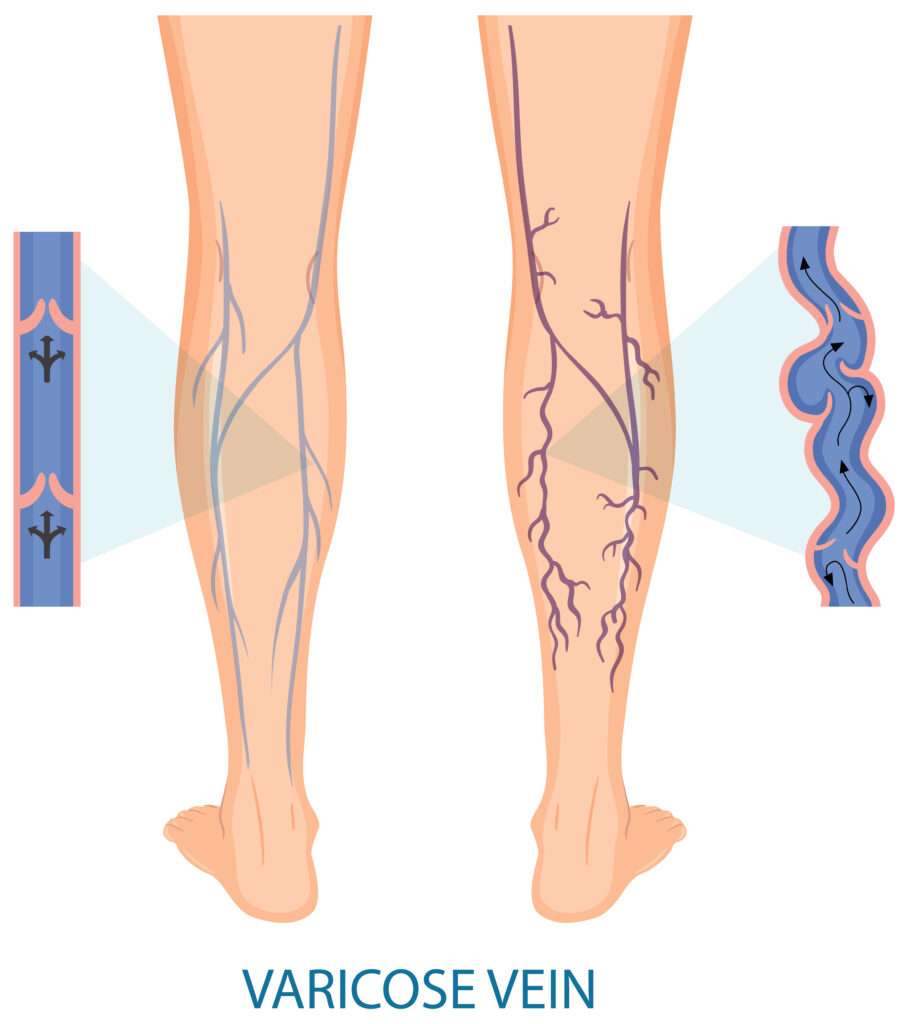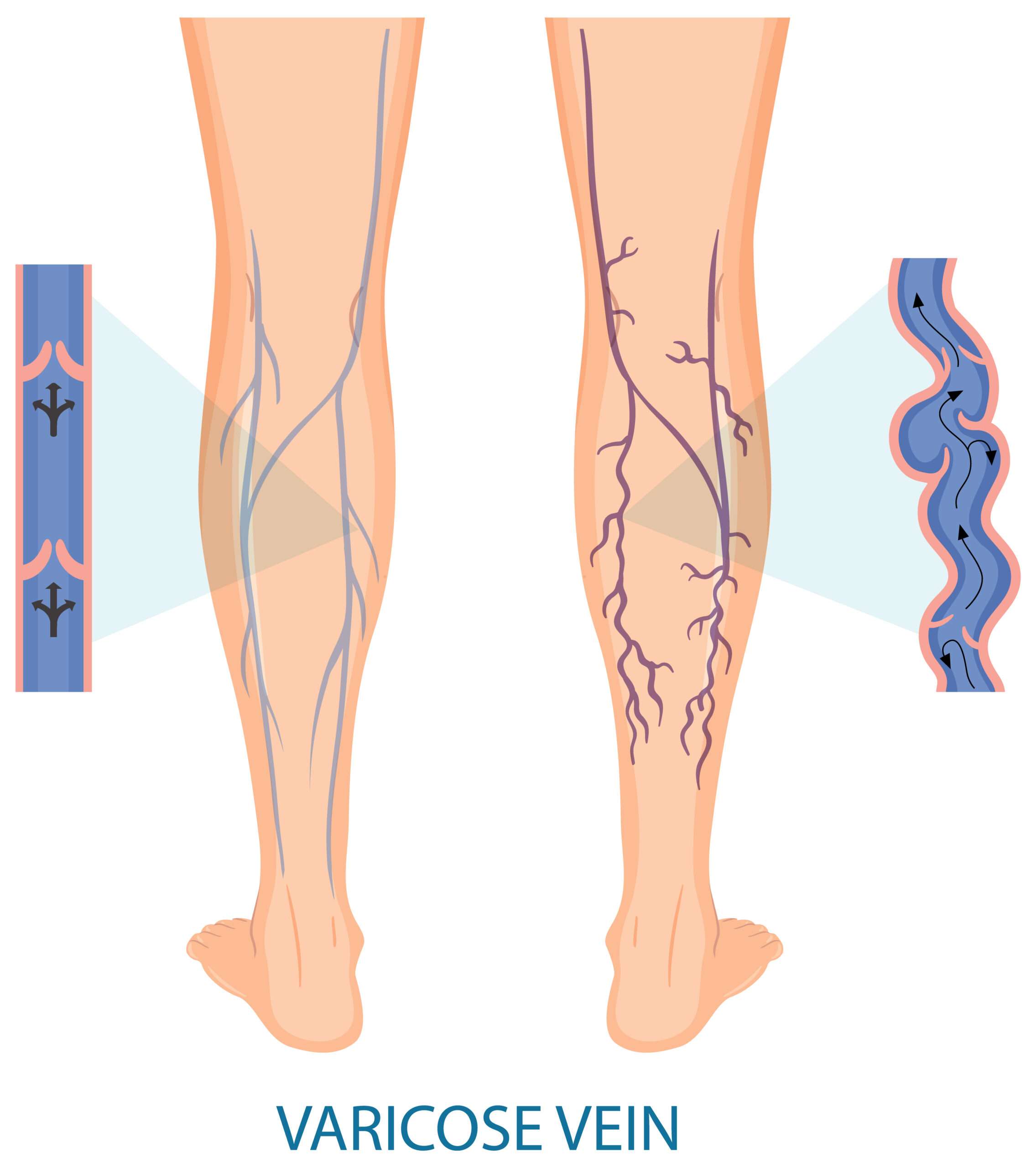
When superficial veins (near the skin) become enlarged and twisted, it is called varicose veins.
It occurs at any part of the body but is more common in the legs. It is not a serious medical condition, and most of the time it does not need any treatment. But sometimes it creates serious complications like pain, discomfort, discoloration of legs, and ulcers.
Veins carry blood back to the heart from all parts of the body. It contains single-way valves. When these valves become weak or damaged, they cannot push the blood. As a result, blood became accumulated and the veins became enlarged and twisted.
CAUSES
The function of veins in the body is to push the blood to the heart from all over the body. It contains a single valve, so the blood flow is in one direction. The valves prevent blood from going in the opposite direction. Varicose veins occur when either there is problem with the valves in the veins or there is some obstruction to the flow of blood
· PRIMARY CAUSES
More than 95% of varicose veins are caused by problems with the valves in the veins. When the valves become weak or damaged, the blood flows in the opposite direction. It results in the pooling of blood in the legs, causing twisted and enlarged superficial veins.
· SECONDARY CAUSES
When there is obstruction to the flow of blood due to any reason. The blood accumulates in the superficial veins of the legs, making them enlarge and twisted. About 5% of varicose veins are caused by secondary causes.
RISK FACTORS
The risk factors for varicose veins
- Sometimes its flow in family we called inherited disease
- Sedentary lifestyle
- Smoking
- Prolong standing and sitting with legs crossed
- Female gender
- Pregnancy
SYMPTOMS
Most of the time, varicose veins do not cause any symptoms. Sometimes it causes symptoms and limits daily activities.
- Heaviness and aches in the legs
- Twisted veins in the legs
- Rashes on the legs near the damaged veins
- Change the color of the skin to red or blue
- Sores and ulcers
DIAGNOSIS
The diagnosis can be done by
- History: Your healthcare provider will take a detailed history from you, including any symptoms you feel, medical and surgical history, family history, and your lifestyle, to know about your activity level.
- Physical examination: Your healthcare provider will do a thorough physical examination of your legs in standing and sitting positions.
- Investigation: Varicose veins can be diagnosed clinically from your history and physical examination. Sometimes your healthcare provider will order an ultrasound called a Doppler or duplex ultrasound. It is a simple, non-invasive investigation to check the blood flow in the veins
TREATMENT
Varicose veins occur in all forms and shapes. Sometimes it is very minimal, causing no symptoms or discomfort. In this case, it requires no treatment. Sometimes it is more severe, causing symptoms and limiting daily activities.
Based on your underlying condition and the level of discomfort it causing, your healthcare provider will advice a treatment from the below list
1. LIFE STYLE CHANGES
Lifestyle modification is necessary to decrease the progression of disease. If the disease is diagnosed in its early stages, just simply modifying your lifestyle will be sufficient without any medical or surgical treatment.
- Maintain a balanced weight decrease the pressure on veins in the legs.
- Physical activity is necessary as the disease progresses with a sedentary lifestyle. Physical activity like walking contracts the muscles in the legs. These contracting muscles put pressure on the veins in the legs to push blood forward.
- The chances of varicose veins and their progression increase in people working, which require standing or sitting for long periods of time.
- Quit smoking, as smoking can damage vein valves. It makes the valve already weak.
2. COMPRESSION BANDS
Compression bands or stockings put pressure on the superficial veins to push the blood to the deep veins. It can be knee length or thigh length, depending upon your level of disease. Although there is no role of compression stockings in the reduction of the progression of disease, it helps to reduce the symptoms and discomfort.
3. ENDOVENOUS THERAPY
- Ultrasound-guided foam sclerotherapy
- Laser therapy
- Radiofrequency therapy
· ULTRASOUND GUIDED FOAM SCLEROTHERAPY
A sclerosing agent is injected into the superficial veins of legs under ultrasound guidance. It makes the veins shrink and fibrose. This therapy improves the symptoms of varicose veins. There are chances that varicose veins will recur after some time.
· LASER Therapy
In this method, a laser fiber is inserted into the superficial veins through ultrasound guidance. The valves are already damaged or weakened. These veins are then destroyed by laser energy.
· RADIOFREQUENCY
This technique of therapy is similar to laser therapy, except in this technique, high thermal energy is used.
4. SURGERY
Superficial veins of legs collect the blood from superficial parts of legs that are from the skin. It goes upward and, at certain points, goes deep to meet the deep veins of the legs. The points where the two meet are behind the knee region and below the inguinal region.
Surgeries of varicose veins consists of
- Ligation of the veins
- Stripping the veins
- Phlebectomy
· HIGH LIGATION AND VEIN STRIPPING
The surgeon makes a transverse cut behind the knee or below the inguinal region. The small saphenous vein and great saphenous veins are identified and ligated where they meet the deep veins of the legs. The superficial veins are then removed.
· PHLEBOTOMY
After the main veins are removed, these even smaller veins do not fade away on their own. The surgeon makes small superficial cuts to remove these small veins.
Complication of varicose veins
- Pain
- Inflammation
- Superficial venous thrombosis
- Deep venous thrombosis
- Venous ulcers
- Pulmonary embolism
Prevention
- Main a balanced weight
- Exercise regularly
- Avoid standing or sitting for too long
- Keep the legs above while sitting and lying
- Quit smoking
- Apply compression stockings
Conclusion
Varicose veins are enlarged and twisted in the lower legs. Although it is not a serious medical condition, in some people it becomes symptomatic and causes pain, heaviness, skin discoloration, and leg ulcers.
There are multiple treatment options available, from simple lifestyle modifications to surgeries. If you feel any symptoms or want to cosmetically correct your varicose veins, see your healthcare provider and discuss treatment options with him.


Leave a Reply